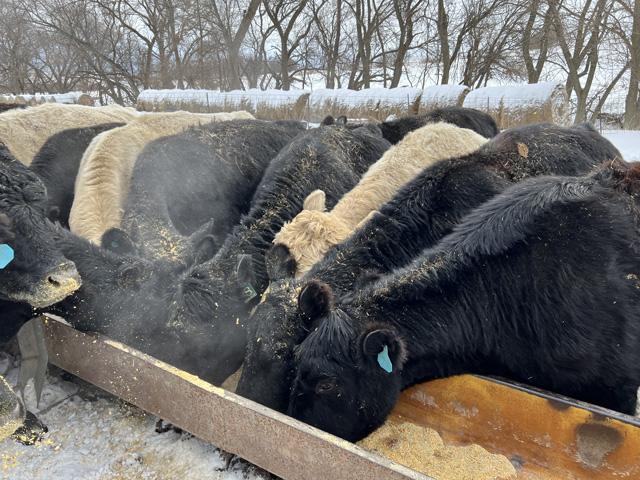Knowing Cattle Body Condition Important
Managing Beef Cattle Body Condition Is Essential for Profitability
OMAHA (DTN) -- One of the most important areas that cow-calf producers need to manage is cow body condition, which is the amount of fat cover a cow carries through various stages of the production cycle. Body condition directly affects calving interval, conception rate and percentage of open cows.
Keeping cows in proper body condition will affect profitability. For spring calving herds, there is still time to economically improve conditions before calving if needed, according to extension specialists.
WATCH BODY CONDITION
James Rogers, North Dakota State University (NDSU) Extension forage crops production specialist, said producers should evaluate body condition scores in their cows. (See https://www.ag.ndsu.edu/…) The scale is a scoring of 1 (emaciated) to 9 (very obese), according to the NDSU press release.
"Research has shown that cows that calve at a body condition score of 5 to 6 will return to estrus in 50 to 60 days. With only 80 days available from calving to rebreeding to stay on a 365-day calving cycle, this does not allow much time," he said.
If body condition scoring is new to you, a University of Nebraska-Lincoln (UNL) Extension report said producers could focus on separating cows into thin, moderate and fat groups without worrying about numerical scores. (See https://beef.unl.edu/…)
Body condition scores should be recorded so that links to productivity and herd management can be examined. Several years of such data could reveal different management changes needed for a given group of cows.
P[L1] D[0x0] M[300x250] OOP[F] ADUNIT[] T[]
It is good training to re-evaluate body condition scores when cattle are wet, according to UNL. Sometimes long, thick hair coats can hide a cow's true body condition. Other factors such as the cow's age, rumen fill and stage of pregnancy can affect visual body condition scores.
"The goal of body condition scoring is to evaluate fatness independent of these factors," the UNL report said. "At first, one or more of the above factors may mislead you, but careful study of your herd through the production year will sharpen your focus so that body condition can be scored independent of the above factors."
Good visuals of body condition scorings can be found at the University of Missouri Extension post titled "Body Condition Scoring of Beef Cattle" (https://extension.missouri.edu/…). Drawings of the different body conditions 1 through 9 are included with this post. A summary of each scoring range is also there.
STILL TIME TO CHANGE BODY CONDITION
NDSU recommends producers take body condition scores now while there is still time to add some condition to cows before calving, if necessary.
"Realize that it takes about 100 pounds of weight change to change one unit on the body condition score," stressed Karl Hoppe, NDSU Extension livestock systems specialist. "If a cow requires such a gain, consider whether you have quality feed supplies on hand to accomplish it."
A forage test can help producers know what they are working with. This test will cost about $20 per sample, he said.
Hoppe pointed out an open cow could cost a producer about $1,200 in lost calf revenue plus cow maintenance costs for a year. The return on investment for a forage test is hard to beat, Hoppe said.
It is a slow process to change the body condition of a cow. When balancing a ration to gain one pound of per day, it will take three months to increase one body condition score unit, he said. Extreme cold weather can decrease one body condition unit quickly if the ration is not changed to include more energy.
The NDSU news release said Rogers "uses an analogy to help visualize body condition scale based on the condition of cat," in the following way:
-- If a cat is round, with no defined shape or waistline, and you can't feel the ribs, the cat has a body condition score of 7 to 9 (on the fat side).
-- If you can see the cat's waist and feel its ribs, but it has a covering of fat down the back with some cover over the ribcage, it is a 5 to 6 (considered ideal).
-- If ribs and hip bones are visible on your cat, and there is a lack of cover down the back and ribs, this cat is a 1-4 and needs to gain weight.
The same is true for cows, Rogers said.
Russ Quinn can be reached at Russ.Quinn@dtn.com
Follow him on X, formerly known as Twitter, @RussQuinnDTN
(c) Copyright 2024 DTN, LLC. All rights reserved.






